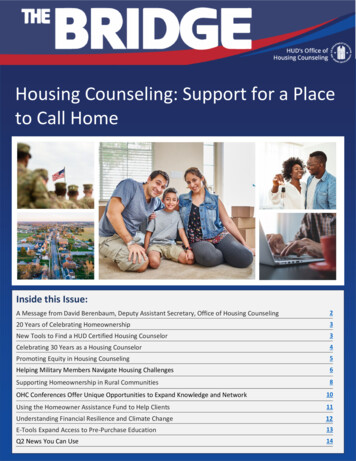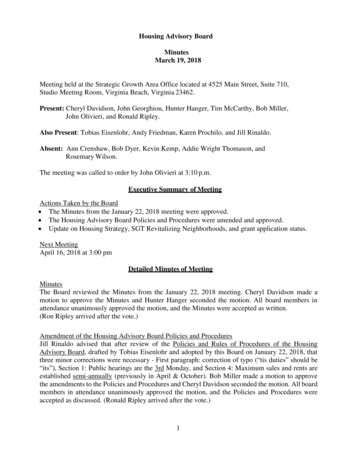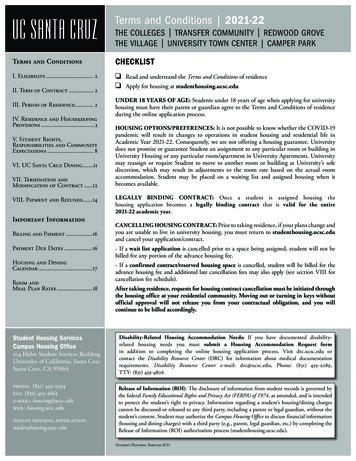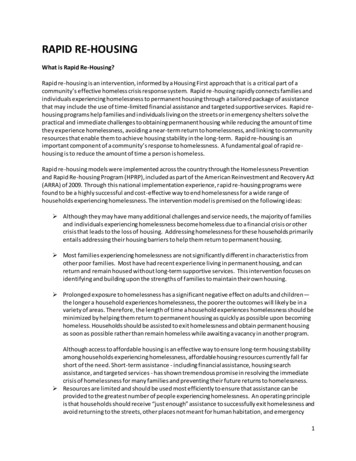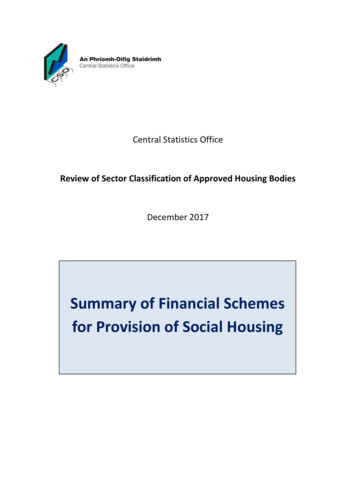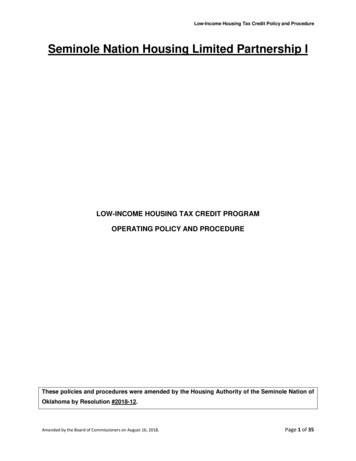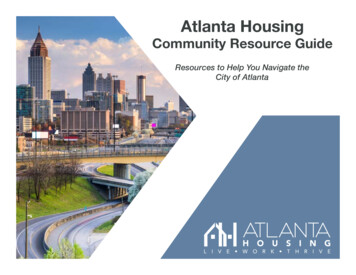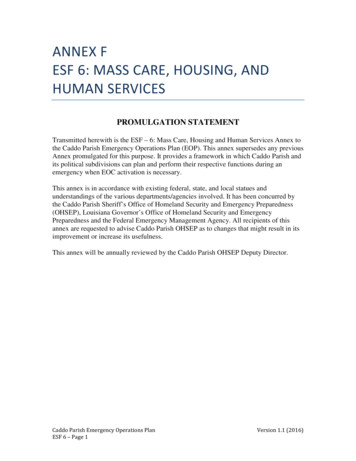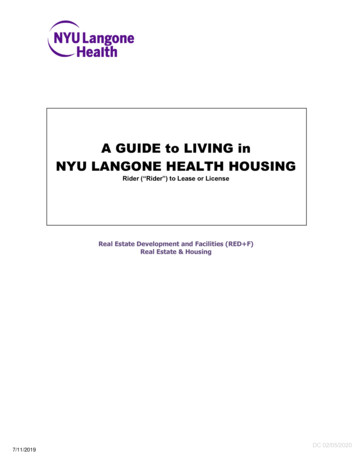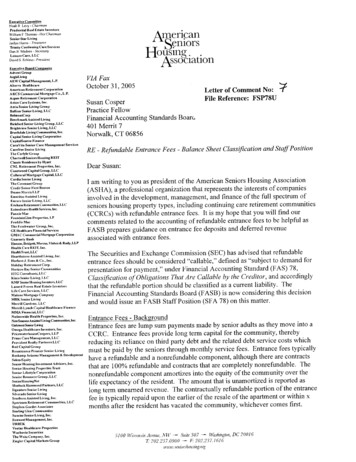
Transcription
Execulive C ymmitteeNoah R Levy· Chall71HlnP,.,.d", li.J Rul [slat" 1. e lorsWI lliam F Thomas· l'ice Cha",nanSeniorStar LivingJaclyn Il arTi s - TreawrerT ri.it y Con tln uinl: Care S",.ic"sO,n B. Madsen . . re/aIJ'Leisu reCa re , l .l.CDavid S Schiess · P",,-,identAmericanSeniorsHousing. .AssoCIatIOnEne"". ,, Ilgard CompaaiesAdvealGroupAqisl.;"in,AILW Ca pi. 1Management,I t'.AltHn Hu lthcareAmeriun Retirement CII"Pur.!ionA RCS Co null er\:ial M ong.!!: Co., L .P.AlP"' Rttiruw nt COI"pora lionAston C II'"t Systelll-5, In (.Alria Smior Living GrollpBa lfour S""Oor Living, LL CBdtllolitCOf"P dt,.n"A.uist"" LnoinClIickford Senior Livin!!: Group, LLCBrightvi" . Se nior Livin g, LLeBrookdllie LivingCommunitlts,lne.C.pital 5""Oor Livi.g C . rpon"ionCapitalSollru Fi . lnuCa ra Vita Se. io r Car" Mana!!:",.",,1 Servic:"JC ar"free S njo r LivingThe Carlyle G roupCl a rtwt:l SttI ion H oll5in, R EITC lau te R"Oduce by Hya tteN!. Rdir",.enl Properties, Iou.COlistwooo Capital Group, LLeCollateral Mortgage Ca pila l, LLCC","dia Seaiof- LiviagTh eCovenlat G roupC redit Sui.l u "' in t llostnnDUllne/l.1orris I.LPi:: meritus A5sisled Livin gF. cou· Senior I"',inl:, Ll.eEn.:e.- R ir t C.""nil . LLClXlendic:.oore Hf'IIlth Servica, In c.Fannie MaeFgunbinGltn Prgp erti .,s, loPFrffld i" Ma rThe . ·rH b . I r G roup , la ( .GIL Htaltheare Fln.nl S«vio:r5C MAC Cnmmercial J\1 grtgllge CorporytiouG uarant,· ij."kIIlnson , 8tio.l w.Man. , VI.hos & Rlldy, LLPHnlllh Care Rt:rr, h,( .tl ealthTnu l, LLClIe11riluto ne A ssisled Livin ll. Inc.Herbe rlJ . Sims & Co., ln r.Holid ay Retiremeu' Corp.lIur"'o . 8.yS niur CO''''''unil aIITG Cgn ulc . "ts, Ll.eKisco Senior Livin ,LLCKJ\U' Mnlot lI nusing '"Venor5, LLCLazard FreIn Rul Estlltf I n ' Ht"n;Life Cll rt Sen-ten, !.I.eMalg ne Mnrlga.te C gnlp"n),MBK Senior LivingMerrill Gardens, LLCM u rill Ly.clI Cilp illllll n lthn re "·i"anceMMA . oc;.1. L1.CNltionwidt Uu lt h Pro p f'r(i , In c.NewSu:!:Ofl' A.rsisted Living Communilid, lnr.Oakmont Sf:nior Lim!;Ome!:" II t.l th care I. vu tl»"l, I nf .Pt ic:no'"tuh,)u.seCo. p u, U . PPrime Cue IIhnMj:emenl, L LCt'rgvid",nl Rdlty I'lirtn . LLCRed Capital G n.u/,R nllli.nn(f Pr",nier S",nior LivingRoobalp A rli.o. Mao ll.tt'"fnt &. Developm atS.lem EquitySenior Housi ng Investm ent" dvisors, In c.Senior Housing Prupert;e, TnutSff'lior Lifu tyle C.-pon tionSuiot Ruou n 'e G"""p: LI,CS,nillrll ouJillgNelShattuck lI ammond }'artnf'r , LLCSic na ture Sen ior I.ivingSjlvtudo SHoio r L;vin eSnuthnn ASSKIN Livi" g, Io,c.Spedru n, Rdiren.e nl Comn".n itic:o!;, LLCSteph en Gordtt A .ocialt,Sterling Gk" Cg mmuniti esS . nrise Sellio r Living, lilt:.Sua .· IIb" .!!: . rtll. (n c.URBEKVelltas H""lth ea re Prop crl''''Wathovi. S uritic5The W ei Co rnp . )', Ill c.2" t 1e' Ca,.itatl\farbts G rO)u(,VIA FaxOctober 31, 2005Susan CosperPractice FellowFinancial Accounting Standards Boare.401 Merrit 7Norwalk, CT 06856Letter of Comment No:File Reference: FSP78URE - Refundable Entrance Fees - Balance Sheet Classification and Staff PositionDear Susan:J am writing to you as president of the American Seniors Housing Association(ASHA), a profess ional organization that represents the interests of com paniesinvolved in the development, managem ent, and finance of the full spectrum ofseniors housing property types, including continuing care retirement communities(CCRCs) with refundable entrance fees. It is my hope that you will find ourcomments related to the accounting of refundabl e entrance fees to be helpful asFASB prepares guidance on entrance fee deposits and deferred revenueassociated with entrance fees.The Securities and Exchange Commission (SEC) has advi sed that refundableentrance fees should be considered "callable," defined as "subject to demand forpresentation for payment," under Financial Accounting Standard (FAS) 78,Classification of Obligations That Are Callable by the Creditor, and accordinglythat the refundable portion should be classified as a current liability. TheFinancial Accounting Standards Board (FA SB) is no w considering this decisionand would issue an FASB Staff Position (S FA 78) on this matter.Entrance Fees - BackgroundEntrance fees are lump sum paym ents made by senior adults as they move into aCCRe. Entrance fees provide long tenn capital for the community, therebyreducing its reliance on third party debt and the related debt service costs whichmust be paid by the seniors through monthly service fe es. Entrance fees typicallyhave a refundable and a nonrefundable component, although there are contractsthat are 100% refundable and contracts that are completely nonrefundable. Thcnonrefundable component amortizes into the equity of the community over thelife expectancy of the resident. The amount that is unamortized is reported aslong tcnn unearned revenue. The contractually refundabl e porti on of the entrancefee is typically repaid upon the earlier of the resa le of the apartment or within xmonths after the res ident has vacated the community, whichever comes first.5100 H·i ;cOTlJ"in A t. nlJe, JVlV -- Suite 307 - I'Vashingwn, DC 20016T 202.237. 0900 - '" 202.2.17.16I1ilI!WW.sen iUfJliousing. () g
Because residents of CCRCs are free to move out at will, the SEC has likened thecontractually refundable portion of an entrance fee to a callable bond, and determined that itshould be classified as a short term liability.We bclieve that re fundable entry fee obligations are not appropriately characterized as"callable," and that they should continuc to be classified as long-term, consi stent with specificcontinuing carc retirement community accounting literature (Chapter 14 of the AICPA Auditand Accounting Guide: Health Care Organizations, previously known as SOP 90-8) andlong-standing accounting and industry practice.Nonetheless, we propose disclosure enhancements and identification of probable refunds duewithin the next fiscal year as a current liability (in addition to those instances whereinreporting entities do not already report a current liability based on contract term s regardingthe refund of vacated living units).Proposal RationaleCCRCs combine elements of hospitality, healthcare and housing in a long term arrangement.Entrance fee agreements are an integral part of the capital structure of the retirementcom munity. We belicve that enhanced disclosurc is a means of providing readers of finan cialstatements with a more expansive understanding of the CCRC cap ital situation.Because it is a fact that a relatively predictable number of contracts will turn over in anycurrent ycar, it may also be desirable to amend Chapter 14 of the AICPA Health Care AuditGu ide to prov ide for the classification of a portion of contractually refundabl e entry feeob li gations as short term, in those instances wherein the reporting entity docs not do so basedon the contract with the entrance fee resident.The discl osure and class ification treatment would satisfY a number of objectives: Reflect the lon g-term economics of the underlying contractual agreementsProvide informati on as (0 the amount of entrance fee obli gations likely to becomedue with 12 monthsA void the creation of current deferred revenues where such is not the caseComport with the standard concepts of working capital and liquidityProv ide more specific narrative disclosure to better inform the reader as to theterms of the contractsRemain consistent with many state regulations that have been deve loped aroundthe guidance previously provided by Chapter 14Preserve consistency and comparabilityChapter 14 and Actuarial ProbabilityChapter 14/S0P 90-8 was the product of careful and informed deliberation and has providedeffective direction for more than 25 years. It has guided the formul ation of individual statestatutes regulating CCRCs and financial covenants of third pany debt. Section 14.22, states2
that advance fees otherwise classifiable as deferred revenues should be recorded as a liability"based on the individual facility's own experience or, if records are not available [as with anew community], on the experience of comparable facilities," The two events that triggerrefunds are death and voluntary move-outs, and both of these events are remarkablypredictable, Historically, in typical entrance fee communities, death of 10%-12% ofresidentsis typical and no more than 1%-3% move out voluntarily in anyone year.Deferred Revenue as Current LiabilityChapter 14 provides guidance as to the determination of what portion of entry fees should beclassified as refundable obligations and what portion should be classified as deferredrevenues. The SEC's directive as to the short term classification of all contractuallyrefundable entry fees leads to the creation of short term deferred revenues in certain instancesand current liabilities in all cases. We do not believe that this is a logical or beneficialaddition to the existing accounting literature.Matching Current Assets with Current Liabilities PrinciplesCCRC refunds are typically paid from the subsequent resale of the vacated apartments, andtherefore refundable entrance fee liabilities generally do not require use of the CCRCsexisting cash balance or other current assets in order to be satisfied. Because new long termliabilities will replace expiring long term liabilities, there should be no need to classify ascurrent any but the known refund obligations because of death or move out. Because entrancefee turnover is such a significantly positive and essential component of CCRC economics, andbecause the refunds do not consume current assets, recording all entry fec refund obligationsas a current liability is misleading.Going Concern UncertaintyThe proposed accounting treatment will cause the financial statements of many entrance feeCCRCs with less-than-one-year contractual refund terms (which arc actually mandated inseveral states) to have extremely unbalanced, negative working capital positions. This willfalsely suggest to the user (lender, investor, 75 year old prospective resident contemplatinginvesting a substantial portion of their net worth to provide care and housing for their lifetime,or existing resident who has already made that investment) that the entrance fee CCRC maynot be a viable and sustainable business model.Currently, there is only one public company whose financials have been re-stated at thedirection of the SEC to reflect all non-contingent entry fee refunds as current, and (aftermoving 119.3m refundable entry fee and deferred revenue from long term (0 current) therestatement left the company with a negative 84.1m working capital imbalance. Theinvestment community appears to have so far completely ignored the large negative workingcapital resulting from this company's restatement. Nonetheless, we urge you to not introducenew accounting applications that require the users of financial statements to "look through"the statements and to ignore commonsense principles of working capital and liability in orderto effectively grasp the true substance of the underlying transactions.3
,Dissimilarity between Callable Bonds and Entrance Fee AgreementsThe SEC's position on entry fee liabilities seems to rest on the analogy between entry fceagreements that are cancelable at the option of the resident and bonds that are callable by theirholders. We believe there are a great many dissimilarities between the two transactions. 'Incentrance fcc refund is not a financial instrument that is callable at the option o f the holder; it isa lifetime interest in a particular space and place. Residence agreements are non-transferablc.To terminate a residency agreement and receive a refund a resident must: I) vacate theirresidence and obtain a new primary residence, 2) give up the lifecare and healthcare benefitsthey "purchased," and 3) suffer the economic detriment of the amortized refund.The accounting literature in Chapter 14 deals with entrance fee agreements specifically, andrather than resort to a questionable analogy with callable bonds in order to resolve aclassification issue that Chapter 14 currently fails to address, we believe it would bepreferable for the guidance in Chapter 14 to be expanded to address it.Supplemental DisclosureWe believe that Chapter 14 reflects the long term nature of all contractual relationships ofatypical CC RC and provides a framework that adequately addresses the acco unting issues. Theentrance fee contract is multi-dimensional and includes occupancy rights and ob ligations(whereas, callablc bonds include none of these features). The contractual parties anticipatethat it will constitute a long-term agreement. In fact, most residents expect that it willcontinue to be in place for the remainder of their Ii fetime.We believe that disclosure is a much more desirable manner to provide the reade r of financialstatements needed informati on than reclassifications of the liability on the balance sheet.Therefore, a suggestion would be enhanced disclosure of the nature of the entrance feeagreements, including a descripti on of contract types, the turnover experience of thecommunity, the amount of refunds paid hi storica ll y, and the current amount of entry fees thatare contractually refundable.Current Portion of Entry Fee LiabilitiesIt is true that a certain number of contracts will turn over each year. Allhough the SEC'sposition on the classification of entry fee obligations is based almost solely on the recognitionthat the contracts arc cancelable (callable), cancellation is a less significant contributor toentry fee turnover than natural mortality and morbidity.It is well established that entrance fee community mortality, morbidity and move-out statisticsare very stable. Accordingly, if enhanced disclosure is deemed inadequate to fully addressGAAP requirements, we believe that Chapter 14 could be augmented with guidance aimed atidentifying the amount of entry fee obligations expected to become due within the currentyear, and that thi s amount could be classified as current. In this case, in addition to thedisclosure requirements listed above, disclosure commentary would also provide the readerwith information regarding the basis used in the determination of amounts classified ascurrent and non-current.4
The Importance of ContinuityIn most states, CCRCs are required to provide annual disclosure statements with auditedfinancial s. Resident and prospective residents and their family and advisors rely heavily onthese statements to evaluate the creditworthiness of the communities and the soundness oftheir existing or prospective entrance fee investment. The classificat ion of entrance feeobligations is a very important one. We believe that the accounting guidance provided byChapter 14 has been responsible and effective for many years, and that it can be updated andsupplemented to provide a responsible and effective solution to the classification issue.David S. SchiessPresident5
J am writing to you as president of the American Seniors Housing Association (ASHA), a professional organization that represents the interests of companies involved in the development, management, and finance of the full spectrum of seniors housing property types, including continuing care retirement communities
